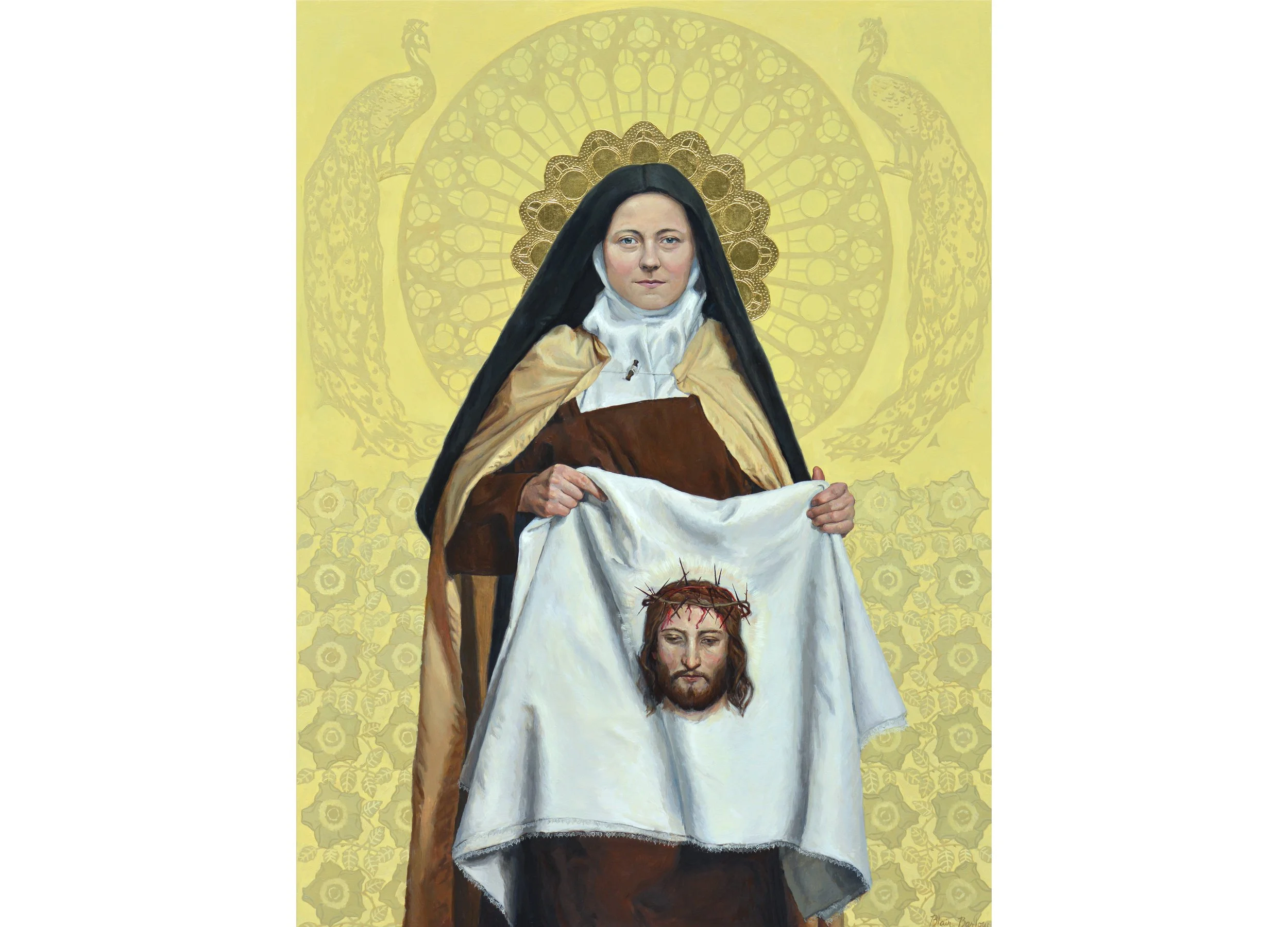St. Therese of the Holy Face
An Essay by Blair Piras
At the beginning of this year, I visited a seasoned artist’s studio and showed her my work for the first time. When she asked me to describe my pieces, I talked about how I like strong patterns. But looking at the collection of my paintings as a whole, I could see that however much I liked patterns, they hadn’t formed a prevailing motif in my work thus far. So when I received my next commission, a portrait of St. Thérèse, I decided to use a pattern to convey the character of her patronage. I wove in different symbols and objects to present St. Thérèse in a fresh way. Here I will try in brief to explain these artistic choices and what they teach us about St. Thérèse and her patronal role.
The piece was commissioned as a gift to Word on Fire Catholic Ministries for the home of the Word on Fire Institute in Irving, Texas. St. Thérèse, though seemingly an unlikely candidate for the title, given her life as a cloistered nun, is the patron of missionary work. She is also Word on Fire’s Patroness. This combination of roles gave me a great deal to think and pray about as I considered how to approach the composition. When representing a well known saint, it is critical to me to help others encounter her on a more profound level than what we find in most popular iconography. Of course, we all know of St. Thérèse as the Little Flower, and the nine day novena to St. Thérèse is perhaps one of the best known novenas among Western Catholics. Likewise, there are innumerable images of St.Thérèse with the crucifix and roses. And while these are her attributes, the common symbols by which we recognize her, there is more we can learn about and from her. When St. Thérèse made her final vows, she took the names of the Child Jesus and of the Holy Face. Though there are some photos of her holding images representing these dual devotions, there are fewer paintings depicting her with the Holy Face of Jesus.
I thus had a moment of inspiration to use the Holy Face of Jesus for this piece, an image that could easily resonate with Word on Fire’s practice of evangelizing through images and media. The stories we have in the traditions of the veil of Veronica in the West and the Mandylion of King Abgar in the East, which were the first images Jesus left of himself, supply the perfect examples for this type of work. In my painting, Jesus is crowned with thorns, painted from a crown of thorns my mother gave me to use in my art, and the thorns are long and severe. Jesus’ beautiful face, the face of greatest love, drips with his precious blood, and light forms a halo around his face. The veil is trimmed with a delicate lace to reference the embroidery and lace work Thérèse did in her life, which she probably learned from her mother, St. Zélie Martin, who owned a lace business.
In the background we see a pattern which further illustrates the mission of Word on Fire and St. Thérèse’s intercessory work from Heaven.The rose window of Notre Dame creates a frame around the saint. Bishop Robert Barron, founder of Word on Fire, has spoken of the magnificent beauty of this great architectural treasure, explaining how it embodies the three essential elements of beauty set forth by St. Thomas: integritas, consonantia, and claritas. Integritas, or completeness, as St. Thomas explains, demands that a beautiful thing “must not be deficient in what it needs to be most itself.” Likewise, in describing consonantia, or proportionality, St. Thomas suggests that the beautiful thing’s “dimensions should suitably correspond to other physical objects as well as to a metaphysical ideal, an end.” Commenting on claritas, or radiance, finally, he says that what is beautiful “should clearly radiate intelligibility, the logic of its inner being, and impress this knowledge of itself on the mind of the perceiver.” The rose window of Notre Dame enframing St. Therese symbolizes Word on Fire’s devotion to evangelizing through beauty. Around the Saint’s head, a floral halo forms a nimbus, while the center part of the window is decorated with gold leaf to honor St. Thérèse as "the little flower." The halo is built up through the raising of some edges and the slight indentation of others to create a pattern.
On either side of the rose window stand two peacocks. I first learned of the symbolism of peacocks in Rome; they adorn many early Christian mosaics in her churches. This symbol has endured through millennia of sacred art, and I happily encountered it again in my own neighborhood at St. Joseph Abbey, where a mural by Dom Gregory De Wit depicts bodily resurrection and features a peacock painted sitting on a sarcophagus. The peacocks in my painting demonstrate St.Thérèse’s promise to “…send down a shower of roses from the heavens; I will spend my heaven doing good upon earth,” as we see a pattern of roses below their feathered tails.
The highlight of creating the piece was when Bishop Barron, who was leading an Abbot’s Conference at the Abbey, came to visit my studio and see the painting in person. I can only thank St. Thérèse for this visit and the opportunity to discuss the work with the Bishop and hear his insights and be inspired by his love for her. As the new year presses on toward spring and I look back on my work, this piece sticks out as one of my favorites. I find that patterns continue to draw me in, and they add a playful, intricate, intriguing element to art. As artists we are always working to create work that carries in it those three qualities of integrity, consonance, and radiance, and what wonderful guiding factors they are!
Blair Piras is a Louisiana artist devoted to making sacred art rooted in Catholic tradition. To learn more about Blair and her art visit www.blairbarlowart.com




